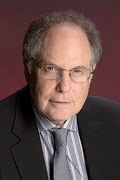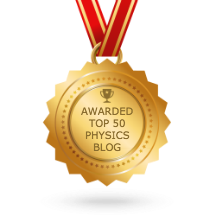 |
| Mark Hallett, from the NIH Record. |
Mark Hallett was a pioneer in using transcranial magnetic stimulation to study the brain. In Intermediate Physics for Medicine and Biology, Russ Hobbie and I describe magnetic stimulation.
8.7 Magnetic Stimulation
Since a changing magnetic field generates an induced electric field, it is possible to stimulate nerve or muscle cells without using electrodes. The advantage is that for a given induced current deep within the brain, the currents in the scalp that are induced by the magnetic field are far less than the currents that would be required for electrical stimulation. Therefore transcranial magnetic stimulation (TMS) is relatively painless. It is also safe (Rossi et al. 2009).
Magnetic stimulation can be used to diagnose central nervous system diseases that slow the conduction velocity in motor nerves without changing the conduction velocity in sensory nerves (Hallett and Cohen 1989). It could be used to monitor motor nerves during spinal cord surgery, and to map motor brain function. Because TMS is noninvasive and nearly painless, it can be used to study learning and plasticity (changes in brain organization over time; Wassermann et al. 2008). Recently, researchers have suggested that repetitive TMS might be useful for treating disorders such as depression (O’Reardon et al. 2007) and Alzheimer’s disease (Freitas et al. 2011).
 |
| Mark Hallett, from the NIH Record. |
One of my first tasks at NIH was to meet with two medical doctors in the National Institute of Neurological Disorders and Stroke—Mark Hallett and Leo Cohen—who had recently begun using magnetic stimulation. Hallett obtained his medical degree from Harvard and was chief of the Human Motor Control Section, housed in NIH’s famous clinical center. He is a leading figure in neurophysiology, specifically in magnetic stimulation research, and is often asked to publish tutorials about magnetic stimulation in leading journals. Hallett once told me that he began college as a physics major but switched to a pre-med program after a year or two. Cohen earned his MD from the University of Buenos Aires in Argentina. In the late 1980s, he worked in Hallett’s section, but eventually became the head of his own Human Cortical Physiology Section at NIH. Together Hallett and Cohen were doing groundbreaking research in magnetic stimulation but lacked the technical expertise in physics required to do things like calculate the electric fields produced by different coils…
Hallett and Cohen obtained a magnetic stimulator at NIH in the late 1980s. They described magnetic stimulation and its potential uses in the Journal of the American Medical Association [Magnetism: A new method forstimulation of nerve and brain. JAMA, 262, 538–541, 1989.], where they highlighted how assessment of central conduction times using magnetic stimulation could be useful for diagnosing diseases, such as multiple sclerosis, and also how the method could be suitable for monitoring the integrity of the spinal cord during surgery. They emphasized that although methods existed to measure the conduction time in the brain for sensory fibers, stimulation of the brain was needed to measure conduction times in central motor fibers.
Not entirely realizing the explosion of research I was lucky enough to be wading into, I started collaborating with Hallett and Cohen to calculate the electric fields produced during magnetic stimulation... Our first work together was a technical paper comparing the electric and magnetic fields produced by a variety of coils with different shapes… Hallett and Cohen were most interested in the electric field induced during transcranial magnetic stimulation, so my next task was to use a three-sphere model to calculate the electric field in the brain...
I was anxious to test the prediction of where excitation occurs along a peripheral nerve during magnetic stimulation [that Peter Basser and I had made]. The ideal experiment would be to dissect a nerve, place it in a dish filled with saline, and then stimulate it. However, Hallett and Cohen were focused mainly on clinical applications, so we tested the prediction in humans. The experiment was performed by Marcela Panizza, an Italian medical doctor, and her husband Jan Nilsson, a biomedical engineer originally from Denmark but working with Panizza in Italy. Panizza and Nilsson would often visit NIH to collaborate with Hallett and Cohen. In the experiment, the median nerve was stimulated at the forearm and the motor response was recorded using electrodesattached to the thumb... [They showed that] that magnetic stimulation did not occur where the electric field was largest, but instead where its spatial derivative was largest.
The research at NIH was assisted by an outstanding group of young scientists who worked with Hallett and Cohen. For example, the Brazilian neurologist Joaquim Brasil-Neto examined how the orientation of the electricfield influenced the stimulation threshold... Peter Fuhr analyzed how the latency of motor-evoked potentials depended on the position of thestimulating coil relative to the head... Eric Wassermann—a medical doctor who trained with Hallett and was editor of the Oxford Handbook of Transcranial Stimulation—wrote a review of safety issues... One of the most serious safety hazards was discovered by Alvaro Pascual-Leone, a Spanish MD/PhD who trained at NIH in the 1990s. Pascual-Leone and his colleagues wanted to record the electroencephalogram (EEG) during and immediately following rapid rate transcranial magnetic stimulation, so they stimulated with silver EEG recording electrodes placed over the scalp. One patient suffered a burn under an electrode.
Hallett was one of my most important collaborators throughout my career. In fact, if you look at Google Scholar to examine my most influential articles (those with over 100 citations each), Hallett was my most common coauthor (13), followed closely by Leo Cohen (11), then my PhD advisor John Wikswo (8), and finally my good friend from NIH Peter Basser (6), who also collaborated with Hallett. One could argue that no other scientist except Wikswo had such an impact on my career.
Hallett was a giant in his field of neurology. He will be missed by many, including me.




















